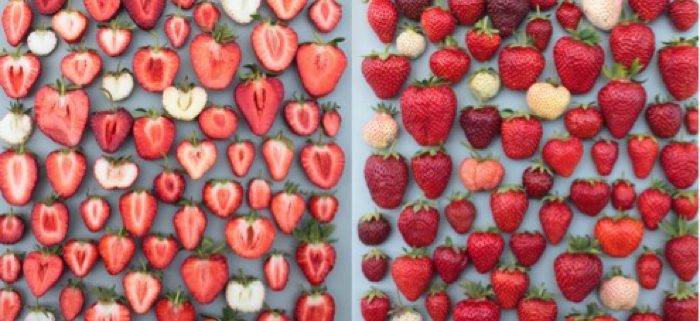MYB10 in Action
Castillejo et al. describe how independent mutations in the transcription factor MYB10 drive natural variation in strawberry color. The Plant Cell (2020) https://doi.org/10.1105/tpc.20.00474
By Cristina Castillejo and Iraida Amaya
Instituto Andaluz de Investigación y Formación Agraria y Pesquera (IFAPA). Centro de Málaga.
Background: The red color of strawberry fruits results from the accumulation of anthocyanins, which are synthesized through the well-known flavonoid pathway. Anthocyanins are synthesized at the endoplasmic reticulum and are later transported into the vacuole for storage via different types of mechanisms. Anthocyanin biosynthesis is induced or repressed through transcriptional regulation of structural genes by transcription factors such as MYB, bHLH, and WD-repeat proteins. A large natural variation in color can be observed in different diploid and octoploid strawberry accessions. Besides contributing to fruit color, anthocyanins possess anti-oxidative properties with beneficial effects on human health.
Question: We wanted to know which genes were responsible for the natural fruit color variation in strawberry. Identification of the genes affecting external (skin) and internal (flesh) fruit color would facilitate the development of molecular markers for the efficient development of new strawberry varieties with increased or reduced levels of anthocyanins.
Findings: We used 12 accessions of diploid strawberry (F. vesca) that produce completely white fruits and seven accessions of octoploid strawberry (F. × ananassa) differing in skin and/or flesh color and compared them to completely red fruits. We found that all analyzed color variants in the genus Fragaria were caused by independent mutations in the same gene, the transcription factor gene MYB10. In diploid Fragaria, we identified three mutant alleles of MYB10 (one was previously described) and a large deletion in chromosome 1 that completely removed the gene. In octoploid strawberry, we found that anthocyanin biosynthesis is activated predominantly by MYB10-2, one of the three MYB10 copies present in this polyploid genome. Two independent mutations of MYB10 were found to be responsible for the white-skin phenotype, while red-flesh color was associated with the presence of a transposon insertion in the MYB10-2 promoter.
Next steps: Our findings reveal a simple genetic control of MYB10 over strawberry skin and flesh color, making it a good target for marker-assisted breeding as well as gene editing using CRISPR-Cas9 technology. In the future, we would like to identify which transcription regulatory sequence(s) provided by the transposon inserted at MYB10-2 promoter drive(s) MYB10-2 induction in fruit flesh.
Castillejo et al. (2020). Allelic Variation of MYB10 is the Major Force Controlling Natural Variation in Skin and Flesh Color in Strawberry (Fragaria spp.) Fruit. Plant Cell DOI: https://doi.org/10.1105/tpc.20.00474.




